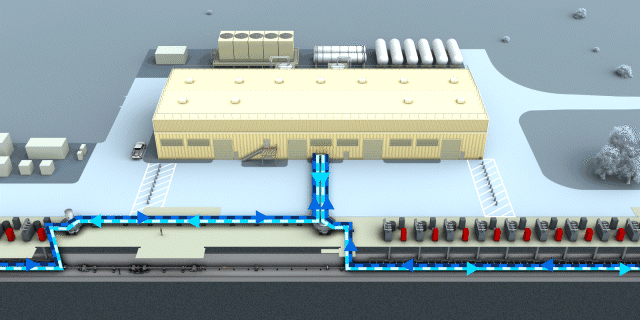Having recently received massive upgrades, the monstrous Linac Coherent Light Source (LCLS) now uses ultra-cold temperatures to accelerate electrons to near the speed of light and can emit up to a million bursts of X-rays. per second.
Substantial improvements
the LCLS-II is what is called a hard X-ray free-electron laser (XFEL), an instrument designed to image microscopic objects at high resolution and at ultrafast timescales. Its previous version had been used in particular to image viruses, recreate the conditions prevailing in the heart of a star, generate the most powerful sound possible or even manufacture the type of ” diamond rain » swooping down on Neptune and Uranus.
Substantial improvements now allow it to emit X-ray pulses 10,000 times brighter than before and at a much higher frequency (one million pulses per second compared to 120 so far).

“In just a few hours, the LCLS-II will produce more X-ray pulses than its predecessor generated during its entire operating life. So data that previously took months can be produced in minutes. “, highlighted Mike Dunnedirector of LCLS. ” It will take X-ray science to the next level, paving the way for a whole new range of studies that will contribute to the development of breakthrough technologies to address some of the most important challenges facing our society.. »
the LCLS-II works in the same way as the first generation: electrons are generated, then accelerated in a long tube, before entering a ” inverter which causes them to oscillate until they emit X-rays in all directions. But it turns out that every step of this process has been improved.
A complex system
The biggest change is to the centrally located throttle. Whereas previously the electrons were sent through a copper tube at room temperature, the LCLS-II uses an array of 37 cryomodules to cool equipment down to -271°C, slightly above absolute zero. To do this, a helium-based coolant is pumped into the modules using two powerful cryogenic pumps.
At such low temperatures, the metallic niobium cavities inside the modules become superconducting, allowing electrons to pass through them without resistance. Microwaves are used to power an oscillating electric field that resonates inside these cavities, synchronizing to the rhythm of passing electrons in order to transfer energy to them. This extra energy accelerates the electrons, so that as they pass through the 37 cryomodules, they travel at near the speed of light.

The electrons then pass through undulators, which use powerful magnets to make them oscillate and thereby emit X-rays. These new undulators can generate X-rays” tough ” and ” soft used for different purposes: hard X-rays can get a detailed picture of individual atoms, while soft X-rays can reveal the flow of energy between atoms and molecules.
The cryomodules of LCLS-II having reached their low temperature in April, the instrument is now ready to be tested with the first electrons. It should start producing X-rays later this year. Once it does, the facility is expected to provide valuable insights into the fields of chemistry, biology, computer science and quantum mechanics.
[related_posts_by_tax taxonomies=”post_tag”]
The post Superconducting X-ray laser reaches temperatures colder than space appeared first on Gamingsym.

